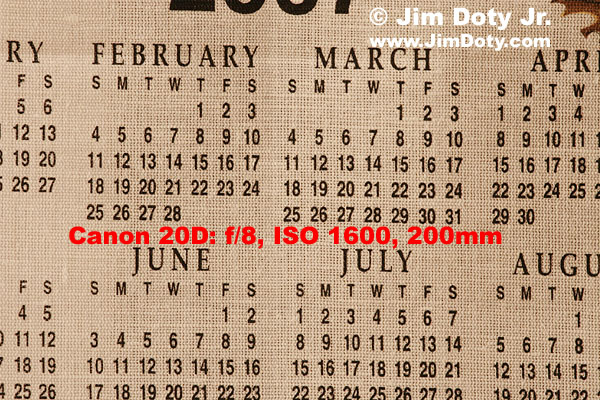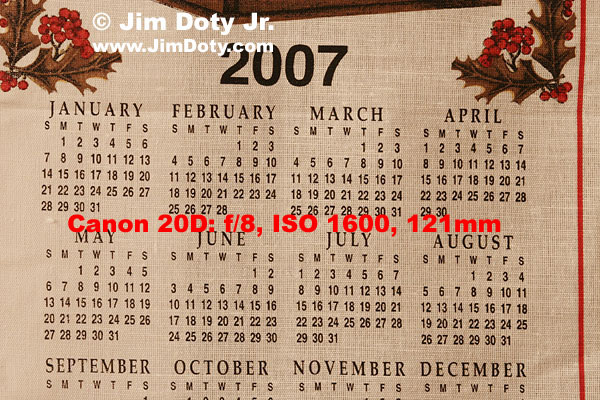IMAGE QUALITY TEST: CANON 20D/30D vs CANON 5D
Does the Canon 5D provide an increase in image quality over the Canon 20D/30D? The debate goes on in forum after forum. When I am asked that question, my usual answer is: "The Canon 5D provides a bigger image, not necessarily a better image." The text and images that follow will illustrate what I mean.
The Canon 5D does have a theoretical advantage: 12.8 megapixels versus 8.2 megapixels and each pixel is 8.2 microns versus 6.4 microns. Having bigger pixels (technically called "photosites") usually means less noise.
Does this translate into a real world advantage? Yes and no. A lot has to do with what you are shooting, how big your prints are, how much you crop, and how long a focal length you are using.
I've been using the 20D since shortly after its introduction, and I've been using the 5D for a year and a half. I do a lot of indoor work without flash at ISO 800 and ISO 1600. To my eye, the noise level (the digital equivalent of film grain) is just about the same for both cameras at high ISO settings. This is confirmed by Phil Askey at DP Review: "The overall noise performance from the EOS 5D is very good and by our measurements almost identical to the EOS 20D." (The source page is here.) Askey has published two Luminance Noise Graphs to illustrate the point. It should be added that the 20D and 30D are essentially the same when it comes to digital noise, as the above linked graphs will illustrate.
Thanks to some comments at a recent forum post, decided to do a simple test this evening to compare resolution. The problem is how to compare. Ideally I would use the same lens at the same focal length and move toward or away from my subject to get the same field of view. But that isn't how I do real world shooting. I pick the camera location for the perspective I want, and then pick a focal length to frame the scene the way I want. If I choose 50mm for a 20D, that means I would pick 80mm for the 5D. Besides, it is dark outside and space inside is limited.
I put a kitchen calendar towel on the wall, and photographed it with a Canon 5D and Canon 20D and used a Canon EF 70-200mm f4L IS lens. I used the lens at 200mm on both cameras. Due to the field of view crop (FOV) on the 20D, the 20D images showed a smaller part of the subject (at a higher magnification) than the 5D. I took another set of photos at 121mm (I had to estimate the focal length, 125mm would have been better) with the Canon 20D to approximate the field of view at 200mm with the Canon 5D. The risk in changing focal lengths is that the test could have more to do with the sharpness of the lens at different focal lengths. But in real world photography, we set the lens to the focal length we want for the field of view that we want once we have determined the tripod location for the perspective we want.
The camera was on a tripod, I used mirror-lockup, the aperture for all photos was f/8 (one of the best for this lens), and I did sets of photos at ISO 100, 400, and 1600. I chose ISO 1600 for the illustrations below since I though that would be more of a test for the cameras since high ISO noise can interfere with detail.
Each description is for the the photo that follows.
This is the original image (reduced to web size) as photographed with the Canon 5D at ISO 1600, at 200mm in focal length. The central focusing point is in March between 18 and 19.

The photo that follows is the original image as photographed with the Canon 20D at 200mm. The reduced field of view due to the FOV crop is obvious.

The photo with the Canon 20D at 121mm looks just about the same as the 5D photo at 200mm.

The photo that follows is the center of the 5D image (lens at 200mm) at 100% magnification (actual pixels). (All of the 100%, "actual pixels", crops below are straight from the camera with no sharpening or other adjustments applied. The different color rendition is due to the picture style settings in the 5D.)

The photo that follows is the center of the 20D image (lens at 200mm) at 100% magnification (actual pixels). Due to the field of view crop, the same area of the calendar is larger and has more detail.

This is the center of the 20D image (lens at 121mm) at 100% magnification (actual pixels). This image is much closer is size to the 5D image due to the shorter focal length of the lens.

Lastly, I down-sized the center of the 20D image at 200mm and up-sized (slightly) the center of the 20D image at 121mm so they would match the center of the 5D image at 200mm to make a side-by-side comparison possible.

Looking at these close-ups isn't the same as looking at real world prints, but they do give us some clues.
With the same lens at the same focal length and the same aperture, the Canon 20D image has a smaller field of view (FOV) than the 5D, but captures that FOV with more detail. Even when the image is down sized to match, there is a slight resolution advantage.
When then lens on the Canon 20D is set to a focal length to give the same field of view as the 5D, the image quality is very close.
After comparing close-ups on my monitor, I went back to the original files and created high quality 12x18 inch prints. At this size (even from very close viewing distances), it is very hard to distinguish between the print from the 5D at 200mm and the print from the 20D at 121mm. From a normal viewing distance there is no visible resolution difference. The print from the 5D has more color due to the way I set up the "picture styles" (as you can see above), but that is the only visible difference.
So why have a Canon 5D if the image quality (at least in prints up to 12x18 inches) is so close? Two reasons. First, having more pixels is definitely better when you really need them. Usually this is when you want to make really big prints (bigger than 12x18 inches), and if you end up doing major cropping to an image. Second, the Canon 5D has a full frame sensor which is an advantage for super wide angle lens work. More about this here. Because of this edge, I use a Canon 5D for most of my shooting.
When you are using your longest lens, and you need all the reach you can get and more, shooting with a Canon 20D is better than with a 5D. This is because of the field of view crop. If your longest lens is 400mm, on a 20D you will have the same field of view as a 640mm lens on the 5D (or a 35mm film camera). This is a very good thing.
What if you shoot with a 5D and crop the image to match the same field of view as you would have with the same focal length on the 20D? You still loose a little. With your longest lens on the 20D, you end up with an 8.2 megapixel image. If you put the same lens on the 5D and crop the image to the same size as the 20D image, you end up with only 5 megapixels. When maximum reach at long focal lengths is paramount, I use a 20D.
Using the original images above, I took the Canon 5D image at 200mm in focal length and cropped it to the same field of view as the Canon 20D image at 200mm. After up-sizing both images, I made 12x18 inch prints. On close examination, the print from the 20D was distinctly sharper than the 5D image, even though I did more sharpening to the 5D image to try and make it equal to the 20D image. The good news for folks with a 5D is that from a normal viewing distance, the resolution differences just about disappear.
What does this all mean in real world photography?
If you have a 20D and you don't need huge prints and don't crop severely into your images, be happy. With 12x18 inch prints and a normal viewing distance (and even closer) the image quality will be very close to the 5D. On the other hand, if you need huge prints or do major cropping, the 5D does have an advantage.
If you are doing long lens work when shooting birds and wildlife, the edge goes to the 20D.
My simple test got a lot more involved than I originally intended and evolved into this article. If I do this kind of test again, it will be outside with more lenses, and I will try zooming with my feet to equalize the field of view.